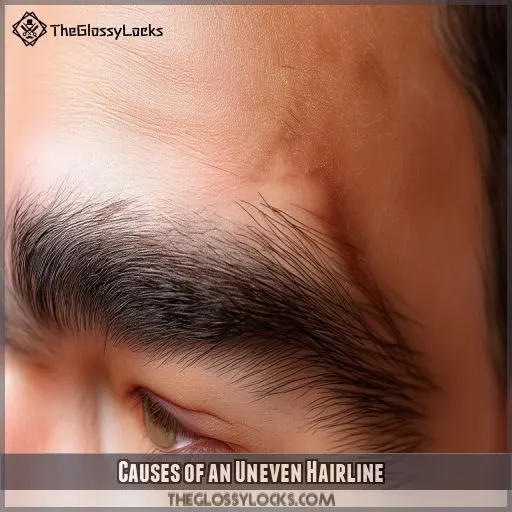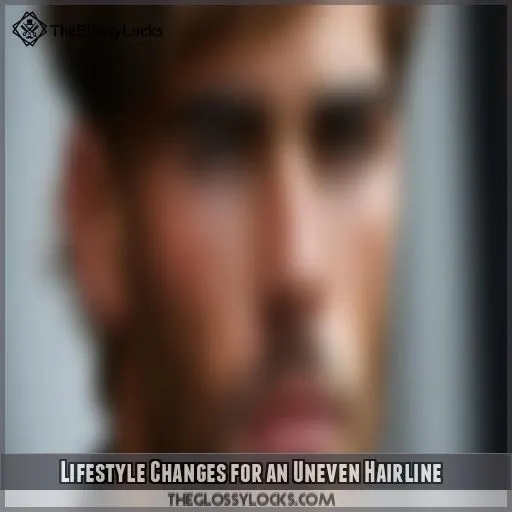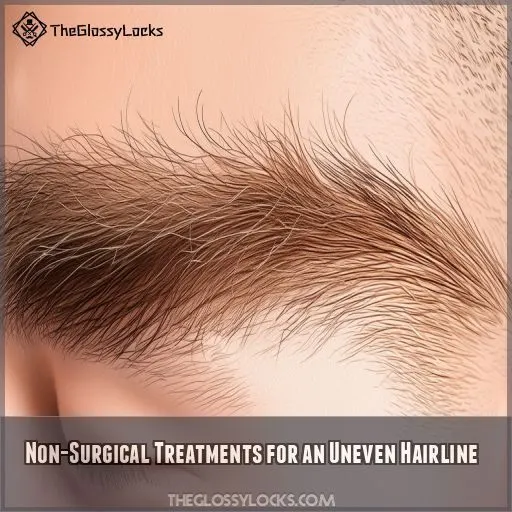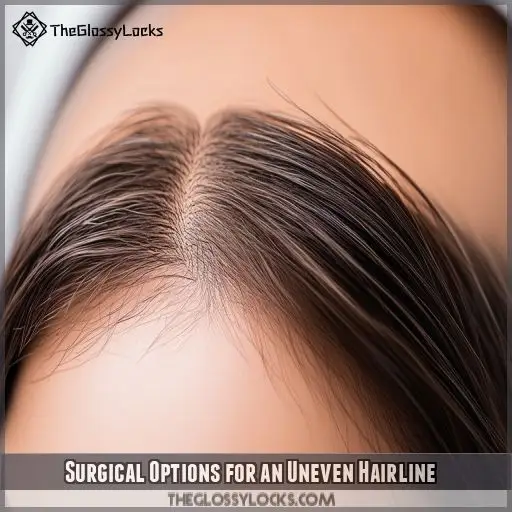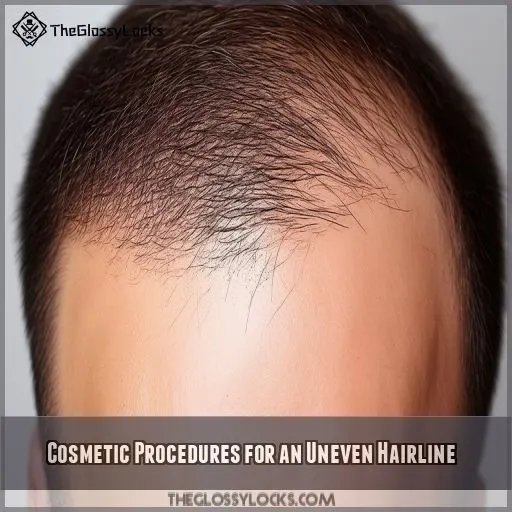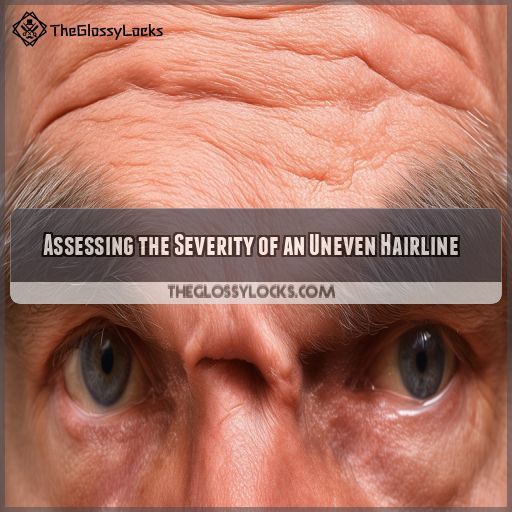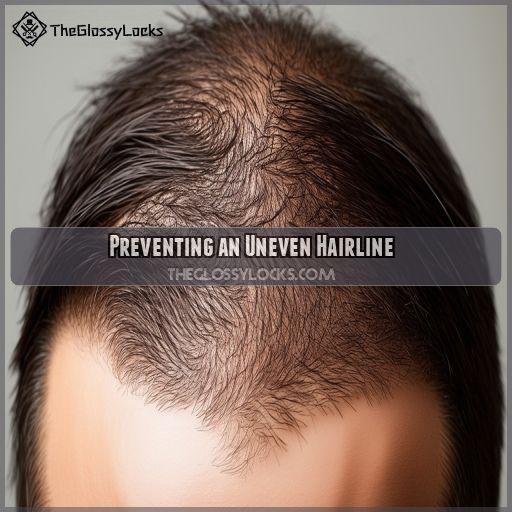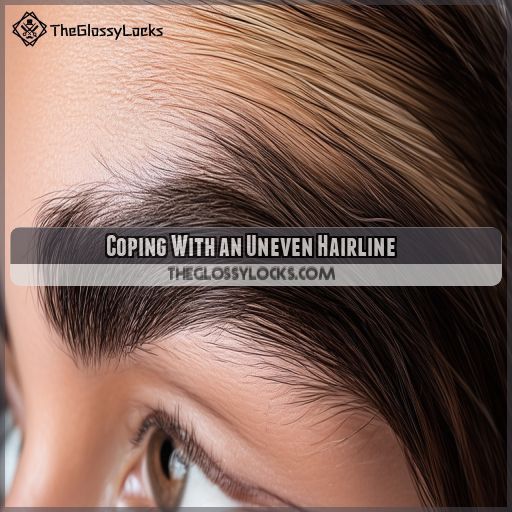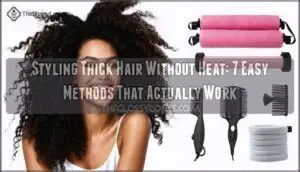This site is supported by our readers. We may earn a commission, at no cost to you, if you purchase through links.
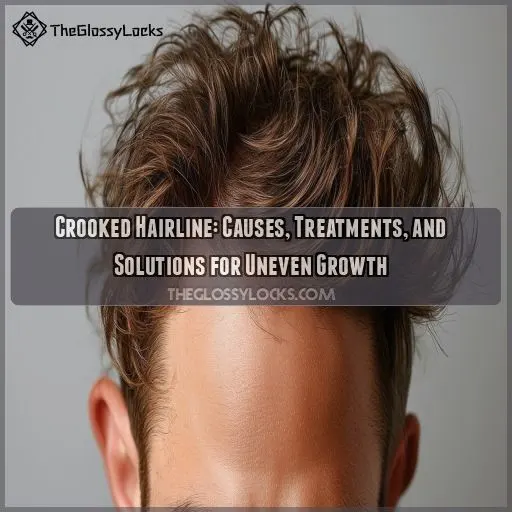 A crooked hairline can be frustrating, but you’re not alone. This uneven growth pattern along your forehead often stems from genetics, traction alopecia, or male pattern baldness.
A crooked hairline can be frustrating, but you’re not alone. This uneven growth pattern along your forehead often stems from genetics, traction alopecia, or male pattern baldness.
Don’t worry, though – there are solutions! You can start by avoiding tight hairstyles and adopting a gentler hair care routine. For more stubborn cases, non-surgical treatments like minoxidil or laser therapy might help.
If you’re looking for a permanent fix, consider FUE hair transplants or hairline lowering surgery. Cosmetic options like micropigmentation or hair extensions can also camouflage unevenness.
Table Of Contents
- Key Takeaways
- Causes of an Uneven Hairline
- Lifestyle Changes for an Uneven Hairline
- Non-Surgical Treatments for an Uneven Hairline
- Surgical Options for an Uneven Hairline
- Cosmetic Procedures for an Uneven Hairline
- Assessing the Severity of an Uneven Hairline
- Preventing an Uneven Hairline
- Coping With an Uneven Hairline
- Frequently Asked Questions (FAQs)
- Can you fix a crooked hairline?
- Why does my hairline look crooked?
- Will a crooked hairline grow back?
- Why is my hairline uneven at 15?
- Can an uneven hairline correct itself over time?
- How does age affect the appearance of hairline asymmetry?
- Are there specific hairstyles that camouflage an uneven hairline?
- Does stress contribute to developing an uneven hairline?
- Can certain vitamins or supplements improve hairline symmetry?
- Conclusion
Key Takeaways
- Don’t pull your hair out over an uneven hairline! It’s often just Mother Nature’s quirky design, but factors like tight ponytails or male pattern baldness can also be the culprits.
- From magic potions to laser beams, there’s a buffet of treatment options to choose from. Whether you’re looking for a quick fix or a long-term solution, there’s something for every taste and budget.
- If you’re feeling brave, surgical options like FUE transplants or hairline lowering can give you a permanent makeover. Just remember, Rome wasn’t built in a day, and neither is a perfect hairline!
- When all else fails, embrace your unique look! After all, some of the world’s most attractive people have unconventional hairlines. Rock what you’ve got, and remember – confidence is the best accessory you can wear.
Causes of an Uneven Hairline
Your uneven hairline could stem from various factors, including genetics, traction alopecia, or male pattern baldness. Understanding these causes is essential, as it’ll help you determine the most effective treatment options and preventive measures for your specific situation.
Genetics
Your uneven hairline might be written in your genes. Heredity plays a significant role in determining hair growth patterns, including:
- Hairline shape and symmetry
- Hair density distribution
- Predisposition to male pattern baldness
- Timing of receding hairline onset
Family traits can influence your hairline’s appearance, making it lean more to one side or have varying density. Understanding your genetic blueprint can help you anticipate and manage potential hair growth challenges.
Traction Alopecia
While genetics play a role, your hairstyle choices can also lead to an uneven hairline. Traction alopecia, caused by excessive tension on your hair, can result in hair breakage and loss. This often stems from:
- Tight braids or ponytails
- Heavy hair extensions
- Frequent use of tight headbands
If you’re experiencing an asymmetrical hairline due to traction alopecia, consider changing your hairstyle and opting for gentler hair care practices to prevent further damage.
Male Pattern Baldness
While traction alopecia stems from external factors, male pattern baldness is an internal culprit behind hairline asymmetry. This hereditary condition can lead to a crooked hairline and uneven hair loss. Here’s what you need to know:
- Hormonal influence: DHT, a byproduct of testosterone, shrinks hair follicles.
- Gradual progression: Hair thinning typically starts at the temples and crown.
- Treatment options: Medications like finasteride or FUE hairline transplants can help combat the issue.
Lifestyle Changes for an Uneven Hairline
If you’re dealing with an uneven hairline, making some lifestyle changes can help improve your hair’s health and appearance. Here are some steps you can take:
- Ditch tight hairstyles that pull on your hair, as these can lead to traction alopecia and hair breakage.
- Boost your diet with nutrient-rich foods and consider dietary supplements to support hair growth.
- Practice stress management techniques like meditation or yoga to reduce hair loss triggered by stress.
- Adopt a gentle hair care routine using natural remedies and avoiding harsh chemicals.
Non-Surgical Treatments for an Uneven Hairline
If you’re looking to address your uneven hairline without surgery, several non-invasive options are available. These include medications like minoxidil or finasteride, low-level laser therapy to stimulate hair growth, and platelet-rich plasma (PRP) therapy, which uses your own blood cells to promote hair regeneration.
Medication
After making lifestyle changes, you might consider medication for your uneven hairline. Two primary options are:
- Minoxidil: A topical hair growth stimulant
- Finasteride: An oral DHT inhibitor
- Topical finasteride: A newer alternative to oral finasteride
- Combination treatments: Using both minoxidil and finasteride
When choosing between Minoxidil vs Finasteride, consider their mechanisms and potential side effects. Topical vs oral administration can affect efficacy and risk. Remember, Finasteride side effects are possible, so consult a healthcare provider before starting any treatment.
Laser Therapy
If medication hasn’t yielded the desired results, you might consider laser therapy for your uneven hairline. This non-invasive treatment uses low-level laser light to stimulate hair follicles and promote growth. Here’s what you need to know:
- Enhances blood flow to the scalp
- Encourages dormant follicles to reactivate
- Improves overall hair density and thickness
While not a miracle cure, laser therapy can be a valuable tool in your hair restoration arsenal, potentially giving your hairline a boost.
PRP Therapy
PRP therapy offers a cutting-edge solution for your uneven hairline. Here’s what you need to know:
- Benefits: Stimulates hair growth and strengthens existing follicles
- Process: Your own blood’s platelets are injected into your scalp
- Maintenance: Multiple sessions required for satisfactory results
While success rates vary, many find PRP effective. Keep in mind potential side effects like scalp tenderness and the higher cost compared to other treatments. It’s a promising option for those seeking innovative hair restoration.
Surgical Options for an Uneven Hairline
If you’re considering surgical options for your uneven hairline, two primary procedures stand out: FUE hair transplants and hairline lowering surgery. FUE transplants involve moving individual hair follicles to create a fuller, more balanced look, while hairline lowering surgery adjusts the position of your entire hairline through scalp advancement techniques.
FUE Hair Transplant
If non-surgical options haven’t yielded results, you might consider a Follicular Unit Extraction (FUE) hair transplant. This surgical procedure can effectively address your uneven hairline. Here’s what you need to know:
- Hair follicle extraction from donor areas
- Careful donor area selection for best results
- Precise graft placement for a natural look
- Recovery process lasting several weeks
- Gradual improvement in hairline symmetry over months
FUE offers a permanent solution, but it’s vital to consult with a skilled surgeon to guarantee the best outcome.
Hairline Lowering Surgery
Hairline lowering surgery can dramatically reshape your forehead, creating a more balanced facial appearance. This procedure involves:
- Removing a strip of scalp
- Advancing the hairline forward
- Carefully closing the incision
Recovery time typically spans 1-2 weeks, with donor area scarring hidden beneath your new hairline. While costs vary, results are often striking. You’ll need to weigh the potential benefits against the surgical risks and expense.
Cosmetic Procedures for an Uneven Hairline
If you’re looking for non-surgical options to address an uneven hairline, cosmetic procedures like micropigmentation and hair extensions can offer quick solutions. Micropigmentation creates the illusion of a fuller hairline through tattooing, while hair extensions can temporarily conceal gaps or unevenness in your natural hairline.
Micropigmentation
If surgical options aren’t for you, micropigmentation offers a non-invasive alternative. This cosmetic procedure creates the illusion of density by tattooing tiny pigment dots on your scalp. Here’s what you need to know:
- It mimics the appearance of hair follicles
- Results can last several years
- Touch-ups may be needed to maintain the effect
Micropigmentation can camouflage hair loss and even out your hairline, giving you a fuller look without surgery.
Hair Extensions
While micropigmentation offers a permanent solution, hair extensions provide a temporary fix for your uneven hairline. These versatile additions can help you achieve a natural look and boost hair volume instantly. With proper hair care and styling techniques, extensions can seamlessly blend with your existing hair.
- Clip-in extensions for easy application and removal
- Tape-in extensions for longer-lasting results
- Fusion extensions for a more permanent solution
Assessing the Severity of an Uneven Hairline
Evaluating the severity of your uneven hairline is essential for determining the best course of action. It’s vital to differentiate between perceived asymmetry and genuine unevenness. Facial asymmetry is common, and what you see as a crooked hairline might be a natural variation. To evaluate your hairline:
- Compare photos of yourself over time to track changes
- Use a mirror and good lighting to examine your hairline closely
- Ask a trusted friend or family member for their opinion
- Consult a dermatologist or trichologist for professional assessment
The impact on your self-esteem can vary, but don’t let it define you. If concealing techniques are necessary, explore hairstyles that complement your facial features. Proper hair care practices can also make a difference in the appearance of your hairline. Remember, slight variations are normal and often unnoticeable to others.
Preventing an Uneven Hairline
Now that you’ve assessed your hairline’s unevenness, let’s focus on prevention. While genetics play a significant role, you can take steps to minimize the risk of developing an uneven hairline. Your hairstyle choice and hair care routine are essential factors in maintaining a balanced growth pattern.
To protect your hairline:
- Opt for looser hairstyles that don’t pull on your scalp
- Use gentle hair products and avoid excessive heat styling
- Maintain a healthy scalp care routine with regular cleansing and moisturizing
Stress management is another key aspect of prevention. High stress levels can disrupt hair growth patterns, potentially leading to uneven growth. Incorporate relaxation techniques into your daily routine, such as meditation or deep breathing exercises. Remember, while you can’t change your genetic predisposition, you can certainly influence your hair’s health through lifestyle choices and proper care.
Coping With an Uneven Hairline
While preventing an uneven hairline is ideal, coping with one can be challenging. Embracing your unique hair asymmetry is key to self-acceptance and overcoming social stigma. Remember, many people have uneven hairlines, and it’s often barely noticeable to others. To boost your confidence and adapt to your hair’s natural growth pattern:
- Experiment with hairstyles that complement your hairline
- Use styling products to create volume and disguise unevenness
- Consider accessories like hats or headbands for versatile looks
- Practice positive self-talk to combat negative thoughts
If the psychological impact of your hairline is affecting your well-being, don’t hesitate to seek support from friends, family, or a therapist. They can help you develop coping strategies and improve your self-image. By focusing on your overall appearance and personal strengths, you’ll find that your hairline is just one small part of what makes you unique and attractive.
Frequently Asked Questions (FAQs)
Can you fix a crooked hairline?
You can’t fix life’s crookedness, but you can tackle your hairline! Try changing hairstyles, using hair products, or exploring medical treatments like finasteride. For severe cases, consider surgical options like FUE hairline transplants. It’s your call!
Why does my hairline look crooked?
Your hairline might look crooked due to genetics, male pattern baldness, or traction alopecia. It’s often a natural asymmetry, but lifestyle factors like tight hairstyles can contribute. Don’t worry; there are various treatments available if it bothers you.
Will a crooked hairline grow back?
Your hairline’s regrowth depends on the cause. If it’s genetic or due to male pattern baldness, it won’t naturally grow back. However, if it’s caused by traction alopecia or styling damage, changing habits can promote regrowth.
Why is my hairline uneven at 15?
At 15, your uneven hairline is likely due to natural development. Genetics play a big role in shaping your hairline. Don’t worry; it’s common during puberty. If you’re concerned, consult a dermatologist for personalized advice.
Can an uneven hairline correct itself over time?
While you might hope for a miracle, an uneven hairline typically doesn’t correct itself. Your best bet is to embrace it or explore treatments. Genetics, age, and hair care practices play key roles in shaping your unique hairline over time.
How does age affect the appearance of hairline asymmetry?
As you age, your hairline’s asymmetry may become more pronounced. Hormonal changes, hair thinning, and follicle miniaturization can exacerbate existing unevenness. You’ll likely notice gradual shifts in your hairline’s shape and density over time.
Are there specific hairstyles that camouflage an uneven hairline?
You can camouflage an uneven hairline with strategic hairstyles. Try side-swept bangs, textured fringes, or layered cuts. Longer styles with volume on top can draw attention away from asymmetry. Experiment with different partings to find your best look.
Does stress contribute to developing an uneven hairline?
Picture stress as a storm cloud over your head. It can indeed contribute to an uneven hairline. When you’re stressed, your body releases hormones that may disrupt hair growth patterns, potentially leading to asymmetrical hair loss.
Can certain vitamins or supplements improve hairline symmetry?
You’ll find that certain vitamins and supplements can support overall hair health, but they won’t directly improve hairline symmetry. B-complex vitamins, biotin, and omega-3 fatty acids may promote healthier hair growth, potentially enhancing your hairline’s appearance over time.
Conclusion
Like a sculptor reshaping clay, you have the power to transform your crooked hairline. Armed with knowledge about causes and treatments, you’re well-equipped to tackle this common concern.
Whether you opt for lifestyle changes, non-surgical interventions, or more permanent solutions, remember that a balanced approach is key. Don’t let an uneven hairline hold you back.
Embrace the journey of self-improvement, and you’ll find the confidence to face the world with your head held high, regardless of your hairline’s shape.

